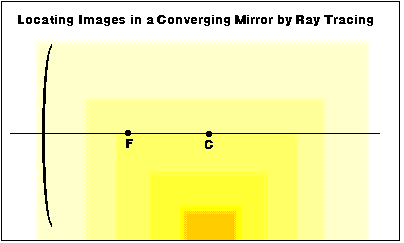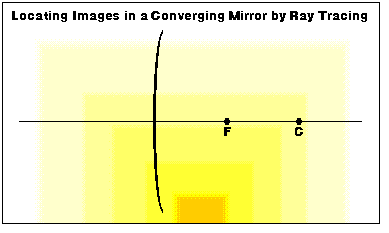
Suppose we place some object in front of a concave mirror. Light will bounce off the object in all directions if it is a diffuse reflector or be produced by it in all directions if it is a candle or a light bulb. Some of this light will strike the concave mirror and reflect from it according to the Law of Reflection. In order to locate any image produced by the mirror, you do not have to trace the paths of an arbitrary number of rays - the three rays discussed on the preceding page will do!
Suppose we place an object in front of a concave mirror, with the bottom of the object resting on the axis of the mirror, at a distance greater than the radius of curvature from the mirror. In order to locate the image:
So where is the image of the tip of the object? A little (well,
maybe a lot of ...) thought should convince you that the only place
that the image can be is at the point of intersection of the three
rays! Notice that this image is IN FRONT OF THE MIRROR! The
image is inverted (upside down), and, in this case, smaller than the
object. It is called a real
image.
Where is the rest of the image? If you trace a ray that leaves the bottom of the object (on the axis), travels down the axis, strikes the mirror, and is reflected back along the axis, you will see that the bottom of the image must also be located on the axis of the mirror as shown in the diagram above. You can also draw the three rays for other points on the object.
Locating an image in this way is called drawing a ray diagram or ray tracing. It is a very common procedure in elementary optics. Notice that the ray diagram not only tells us the location of the image, but also its size and orientation (right-side up or upside down). This makes a ray diagram a very convenient and useful tool.
If the object is closer than one focal length from the mirror, something surprising happens. As shown in the diagram, the object produces an upright, enlarged, virtual image behind the mirror! Converging mirrors can produce both real and virtual images!
